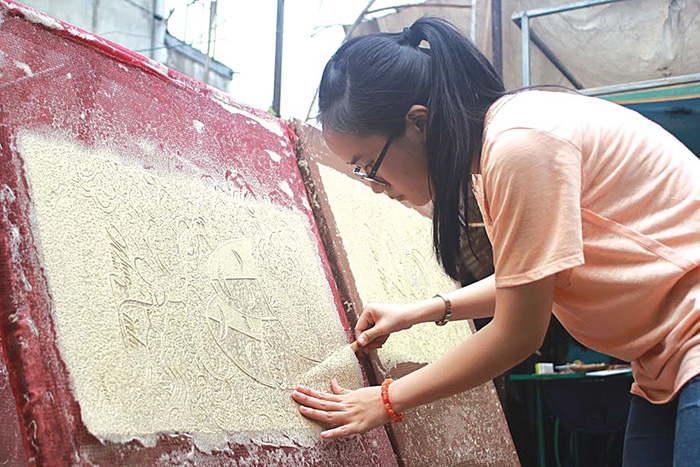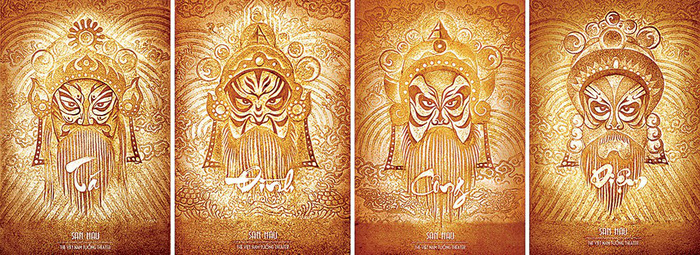Trucchigraphy, a paper embossing art originating in Vietnam, has been honored with a top prize at the 2017 American Graphic Design Awards thanks to the ardent works of an art student.
Organized by New York-based magazine Graphic Design USA, the awards attracted nearly 10,000 submissions from international artists and graphic designers who competed in such categories as Internet design, infographics, sales promotion and identity design.
The culturally inclined project by 23-year-old Vietnamese art student Dang Thi Bich Ngoc, which intertwined tradition with modernity thanks to her clever use of trucchigraphy, was crowned the winner of the Student Design category.
“This is the first time the Vietnamese papercraft of trucchigraphy has been listed as an official art form at an international contest,” said Tran Thanh Binh, a professor of applied arts at the Hue University of Fine Arts, where Ngoc was a student.
The name trucchigraphy stems from the Sino-Vietnamese term ‘truc chi,’ which literally means bamboo paper.
As the name suggests, the art revolves around embossing and debossing paper made from the fibers of bamboo trees.
Though the art itself is relatively modern, having been created in the early 2000s by Vietnamese artist Phan Hai Bang and his colleagues at Hue University, the traditional papermaking technique from bamboo fibers had been around for much longer in Vietnam.
The difference between trucchigraphy and other paper embossing techniques is that the paper is embossed while it is still wet, allowing the finished product to have a unique translucent effect.
 |
| Dang Thi Bich Ngoc works on her trucchigraphic posters. Courtesy of Ngoc |
Sweat and blood
Ngoc, who has just graduated with a bachelor’s degree in graphic design from Da Nang Architecture University, began her journey with trucchigraphy in April 2017 when she was seeking the right material for her graduation project, which was to design a collection of posters for a traditional musical event.
With less than a month to finish her project, Ngoc packed up and traveled to Hue to seek consultations from the master of trucchigraphy himself – artist Phan Hai Bang – and learned the entire process of making a trucchigraphic product.
Her first-hand experience with the art had been far from what she had read on the Internet, Ngoc recalled, as it required extreme attention to detail and hard work.
After successfully defending her thesis with flying-colors grades, Ngoc was determined to return to Hue to perfect her skill with another trucchigraphic project.
“I thought to myself that I would have to give the art my sweat and blood to truly understand it,” Ngoc said.
After two months living and working full-time at the Truc Chi Garden in Hue, Ngoc was finally able to master the delicate techniques of trucchigraphy from bamboo to paper to create her award-winning posters.
The four-piece collection includes trucchigraphic portraits of characters in the classical Vietnamese opera of ‘San Hau,’ each with their own distinctive facial features representative of their respective characteristics.
The theatrical genre, known in Vietnamese as ‘tuong,’ combines dance, singing and folk music and was a highly popular art form for commoners until the 20th century.
“As a national heritage, tuong is a precious language of expression for the Vietnamese people that needs preserving and promoting,” Ngoc explained.
According to graphic designer Nguyen Tri Phuong Dong, who won the Editorial Design Award at the 2014 American Graphic Design Awards, Ngoc’s project was successful because it managed to capture two cultural aspects of Vietnamese arts – tuong and trucchigraphy.
“Her decision to choose trucchigraphy as the means of expression for tuong certainly caught the judges’ attention,” Dong explained.
“Theatrical or cinematic posters always need to come off well under special lighting effects, while trucchigraphy is known to excel in this regard.”
Like us on Facebook or follow us on Twitter to get the latest news about Vietnam!



















































